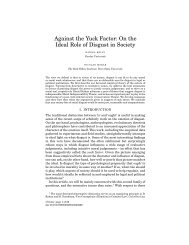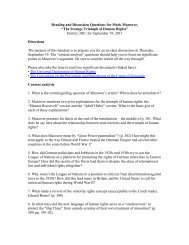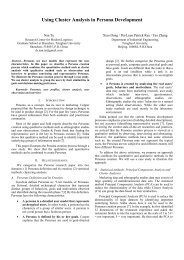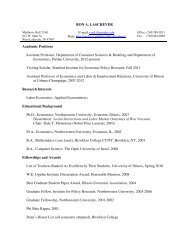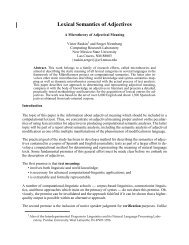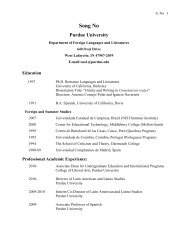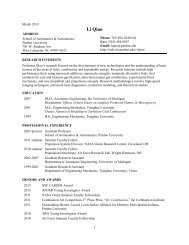Parsons 1942 - Career Account Web Pages
Parsons 1942 - Career Account Web Pages
Parsons 1942 - Career Account Web Pages
You also want an ePaper? Increase the reach of your titles
YUMPU automatically turns print PDFs into web optimized ePapers that Google loves.
Age and Sex in the Social Structure of the United States<br />
Author(s): Talcott <strong>Parsons</strong><br />
Source: American Sociological Review, Vol. 7, No. 5 (Oct., <strong>1942</strong>), pp. 604-616<br />
Published by: American Sociological Association<br />
Stable URL: http://www.jstor.org/stable/2085686 .<br />
Accessed: 13/11/2013 17:34<br />
Your use of the JSTOR archive indicates your acceptance of the Terms & Conditions of Use, available at .<br />
http://www.jstor.org/page/info/about/policies/terms.jsp<br />
.<br />
JSTOR is a not-for-profit service that helps scholars, researchers, and students discover, use, and build upon a wide range of<br />
content in a trusted digital archive. We use information technology and tools to increase productivity and facilitate new forms<br />
of scholarship. For more information about JSTOR, please contact support@jstor.org.<br />
.<br />
American Sociological Association is collaborating with JSTOR to digitize, preserve and extend access to<br />
American Sociological Review.<br />
http://www.jstor.org<br />
This content downloaded from 128.210.126.199 on Wed, 13 Nov 2013 17:34:48 PM<br />
All use subject to JSTOR Terms and Conditions
J<br />
AGE AND SEX IN THE SOCIAL STRUCTURE<br />
OF THE UNITED STATES*<br />
TALCOTT PARSONS<br />
Harvard University<br />
Points of interest. Male, female, and youth cultures in our society.<br />
Significance of the "swell guy" and "glamor girl." The isolation of<br />
old age in America. German versus American youth cultures. Adult<br />
male specialization versus the "common human" values of youth. The<br />
domestic, the glamorous, and the good-companion roles of women.<br />
Are sex roles becoming more alike or unlike? Sex roles and the<br />
difficulty of maintaining companionship in modern marriage. [Ed.]<br />
N OUR society age grading does not to any great extent, except for the<br />
educational system, involve formal age categorization, but is interwoven<br />
with other structural elements. In relation to these, however, it<br />
constitutes an important connecting link and organizing point of reference<br />
in many respects. The most important of these for present purposes are kinship<br />
structure, formal education, occupation and community participation.<br />
In most cases the age lines are not rigidly specific, but approximate; this<br />
does not, however, necessarily lessen their structural significance.'<br />
In all societies the initial status of every normal individual is that of child<br />
in a given kinship unit. In our society, however, this universal starting point<br />
is used in distinctive ways. Although in early childhood the sexes are not<br />
usually sharply differentiated, in many kinship systems a relatively sharp<br />
segregation of children begins very early. Our own society is conspicuous<br />
* The substance of this paper was presented to the American Sociological Society on<br />
December 27, I94I, at New York City.<br />
The attempt to embark on this analysis was suggested to the writer largely by Professor<br />
Ralph Linton, through his paper, "A Neglected Aspect of Social Structure," American journal<br />
of Sociology, May, I940, and through personal conversation. Both the general analytical<br />
significance of age and sex categories in social structure, and the main outline of the cultural<br />
variability of particular modes of organization of age and sex roles are taken for granted in<br />
the present paper. Professor Linton has amplified his treatment of these subjects in the preceding<br />
article in this issue of the Review.<br />
The present paper will not embody the results of systematic research but constitutes rather<br />
a tentative statement of certain major aspects of the role of age and sex in our society and of<br />
their bearing on a variety of problems. It will not attempt to treat adequately the imporant<br />
variatons according to social class, rural-urban differences, and so on, but will concentrate<br />
particularly on the urban middle and upper middle classes.<br />
1 The problem of organization of this material for systematic presentation is, in view of<br />
this fact, particularly difficult. It would be possible to discuss the subject in terms of the<br />
above four principal structures with which age and sex are most closely interwoven, but there<br />
are serious disadvantages involved in this procedure. Age and sex categories constitute one<br />
of the main links of structural continuity in terms of which structures which are differentiated<br />
in other respects are articulated with each other; and in isolating the treatment of these<br />
categories there is danger that this extremely important aspect of the problem will be lost<br />
sight of. The least objectionable method, at least within the limits of space of such a paper,<br />
seems to be to follow the sequence of the life cycle.<br />
604<br />
This content downloaded from 128.210.126.199 on Wed, 13 Nov 2013 17:34:48 PM<br />
All use subject to JSTOR Terms and Conditions
AGE AND SEX IN U. S. SOCIAL STRUCTURE<br />
for the extent to which children of both sexes are in many fundamental respects<br />
treated alike. This is particularly true of both privileges and responsibilities.<br />
The primary distinctions within the group of dependent siblings<br />
are those of age. Birth order as such is notably neglected as a basis of discrimination;<br />
a child, of eight and a child of five have essentially the privileges<br />
and responsibilities appropriate to their respective age levels without<br />
regard to what older, intermediate, or younger siblings there may be. The<br />
preferential treatment of an older child is not to any significant extent differentiated<br />
if and because he happens to be the first born.<br />
There are, of course, important sex differences in dress and in approved<br />
play interest and the like, but if anything, it may be surmised that in the<br />
urban upper middle classes these are tending to diminish. Thus, for instance,<br />
play overalls are essentially similar for both sexes. What is perhaps the<br />
most important sex discrimination is more than anything else a reflection<br />
of the differentiation of adult sex roles. It seems to be a definite fact that<br />
girls are more apt to be relatively docile, to conform in general according<br />
to adult expectations, to be "good," whereas boys are more apt to be recalcitrant<br />
to discipline and defiant of adult authority and expectations. There<br />
is really no feminine equivalent of the expression "bad boy." It may be suggested<br />
that this is at least partially explained by the fact that it is possible<br />
from an early age to initiate girls directly into many important aspects of<br />
the adult feminine role. Their mothers are continually about the house and<br />
the meaning of many of the things they are doing is relatively tangible and<br />
easily understandable to a child. It is also possible for the daughter to participate<br />
actively and usefully in many of these activities. Especially in the<br />
urban middle classes, however, the father does not work in the home and<br />
his son is not able to observe his work or to participate in it from an early<br />
age. Furthermore many of the masculine functions are of a relatively abstract<br />
and intangible character, such that their meaning must remain almost<br />
wholly inaccessible to a child. This leaves the boy without a tangible<br />
meaningful model to emulate and without the possibility of a gradual initiation<br />
into the activities of the adult male role. An important verification of<br />
this analysis could be provided through the study in our own society of the<br />
rural situation. It is my impression that farm boys tend to be "good" in<br />
a sense in which that is not typical of their urban brothers.<br />
The equality of privileges and responsibilities, graded only by age but<br />
not by birth order, is extended to a certain degree throughout the whole<br />
range of the life cycle. In full adult status, however, it is seriously modified<br />
by the asymmetrical relation of the sexes to the occupational structure. One<br />
of the most conspicuous expressions and symbols of the underlying equality,<br />
however, is the lack of sex differentiation in the process of formal education,<br />
so far, at least, as it is not explicitly vocational. Up through college differentiation<br />
seems to be primarily a matter on the one hand of individual<br />
6o5<br />
This content downloaded from 128.210.126.199 on Wed, 13 Nov 2013 17:34:48 PM<br />
All use subject to JSTOR Terms and Conditions
6o6<br />
AMERICAN SOCIOLOGICAL REVIEW<br />
ability, on the other hand of class status, and only to a secondary degree<br />
of sex differentiation. One can certainly speak of a strongly established<br />
pattern that all children of the family have a "right" to a good education,<br />
rights which are graduated according to the class status of the family but<br />
also to individual ability. It is only in post-graduate professional education,<br />
with its direct connection with future occupational careers, that sex discrimination<br />
becomes conspicuous. It is particularly important that this<br />
equality of treatment exists in the sphere of liberal education since throughout<br />
the social structure of our society there is a strong tendency to segregate<br />
the occupational sphere from one in which certain more generally human<br />
patterns and values are dominant, particularly in informal social life and<br />
the realm of what will here be called community participation.<br />
Although this pattern of equality of treatment is present in certain fundamental<br />
respects at all age levels, at the transition from childhood to adolescence<br />
new features appear which disturb the symmetry of sex roles while<br />
still a second set of factors appears with marriage and the acquisition of full<br />
adult status and responsibilities.<br />
An indication of the change is the practice of chaperonage, through which<br />
girls are given a kind of protection and supervision by adults to which boys<br />
of the same age group are not subjected. Boys, that is, are chaperoned only<br />
in their relations with girls of their own class. This modification of equality<br />
of treatment has been extended to the control of the private lives of women<br />
students in boarding schools and colleges. Of undoubted significance is the<br />
fact that it has been rapidly declining not only in actual effectiveness but<br />
as an ideal pattern. Its prominence in our recent past, however, is an important<br />
manifestation of the importance of sex role differentiation. Important<br />
light might be thrown upon its functions by systematic comparison with the<br />
related phenomena in Latin countries where this type of asymmetry has<br />
been far more sharply accentuated than in this country in the more modern<br />
period.<br />
It is at the point of emergence into adolescence that there first begins to<br />
develop a set of patterns and behavior phenomena which involve a highly<br />
complex combination of age grading and sex role elements. These may be<br />
referred to together as the phenomena of the "youth culture." Certain of its<br />
elements are present in pre-adolescence and others in the adult culture.<br />
But the peculiar combination in connection with this particular age level is<br />
unique and highly distinctive for American society.<br />
Perhaps the best single point of reference for characterizing the youth<br />
culture lies in its contrast with the dominant pattern of the adult male role.<br />
By contrast with the emphasis on responsibility in this role, the orientation<br />
of the youth culture is more or less specifically irresponsible. One of its<br />
dominant notes is "having a good time" in relation to which there is a particularly<br />
strong emphasis on social activities in company with the opposite<br />
This content downloaded from 128.210.126.199 on Wed, 13 Nov 2013 17:34:48 PM<br />
All use subject to JSTOR Terms and Conditions
AGE AND SEX IN U. S. SOCIAL STRUCTURE 607<br />
sex. A second predominant characteristic on the male side lies in the<br />
prominence of athletics, which is an avenue of achievement and competition<br />
which stands in sharp contrast to the primary standards of adult achievement<br />
in professional and executive capacities. Negatively, there is a strong<br />
tendency to repudiate interest in adult things and to feel at least a certain<br />
recalcitrance to the pressure of adult expectations and discipline. In addition<br />
to, but including, athletic prowess the typical pattern of the male<br />
youth culture seems to lay emphasis on the value of certain qualities of attractiveness,<br />
especially in relation to the opposite sex. It is very definitely<br />
a rounded humanistic pattern rather than one of competence in the performance<br />
of specified functions. Such stereotypes as the "swell guy" are<br />
significant of this. On the feminine side there is correspondingly a strong<br />
tendency to accentuate sexual attractiveness in terms of various versions<br />
of what may be called the "glamor girl" pattern.2 Although these patterns<br />
defining roles tend to polarize sexually-for instance, as between star athlete<br />
and socially popular girl-yet on a certain level they are complementary,<br />
both emphasizing certain features of a total personality in terms of the<br />
direct expression of certain values rather than of instrumental significance.<br />
One further feature of this situation is the extent to which it is crystallized<br />
about the system of formal education.3 One might say that the principal centers<br />
of prestige dissemination are the colleges, but that many of the most<br />
distinctive phenomena are to be found in high schools throughout the country.<br />
It is of course of great importance that liberal education is not primarily<br />
a matter of vocational training in the United States. The individual status<br />
2<br />
Perhaps the most dramatic manifestation of this tendency lies in the prominence of the<br />
patterns of "dating," for instance among college women. As shown by an unpublished participant-observer<br />
study made at one of the Eastern Women's colleges, perhaps the most important<br />
single basis of informal prestige rating among the residents of a dormitory lies in their<br />
relative dating success-though this is by no means the only basis. One of the most striking<br />
features of the pattern is the high publicity given to the "achievements" of the individual in<br />
a sphere where traditionally in the culture a rather high level of privacy is sanctioned-it is<br />
interesting that once an engagement has occurred a far greater amount of privacy is granted.<br />
The standards of rating cannot be said to be well integrated, though there is an underlying<br />
consistency in that being in demand by what the group regards as desirable men is perhaps<br />
the main standard.<br />
It is true that the "dating" complex need not be exclusively bound up with the "glamor<br />
girl" stereotype of ideal feminine personality-the "good companion" type may also have<br />
a place. Precisely, however, where the competitive aspect of dating is most prominent the<br />
glamor pattern seems heavily to predominate, as does, on the masculine side, a somewhat<br />
comparable glamorous type. On each side at the same time there is room for considerable difference<br />
as to just where the emphasis is placed-for example as between "voluptuous" sexuality<br />
and more decorous "charm."<br />
3 A central aspect of this focus of crystallization lies in the element of tension, sometimes<br />
of direct conflict, between the youth culture patterns of college and school life, and the "serious"<br />
interests in and obligations toward curricular work. It is of course the latter which defines<br />
some at least of the most important foci of adult expectations of doing "good" work and justifying<br />
the privileges granted. It is not possible here to attempt to analyze the interesting,<br />
ambivalent attitudes of youth toward curricular work and achievement.<br />
This content downloaded from 128.210.126.199 on Wed, 13 Nov 2013 17:34:48 PM<br />
All use subject to JSTOR Terms and Conditions
6o8<br />
AMERICAN SOCIOLOGICAL REVIEW<br />
on the curricular side of formal education is, however, in fundamental ways<br />
linked up with adult expectations, and doing "good work" is one of the most<br />
important sources of parental approval. Because of secondary institutionalization<br />
this approval is extended into various spheres distinctive of the youth<br />
culture. But it is notable that the youth culture has a strong tendency to develop<br />
in directions which are either on the borderline of parental approval<br />
or beyond the pale, in such matters as sex behavior, drinking and various<br />
forms of frivolous and irresponsible behavior. The fact that adults have<br />
attitudes to these things which are often deeply ambivalent and that on<br />
such occasions as college reunions they may outdo the younger generation,<br />
as, for instance, in drinking, is of great significance, but probably structurally<br />
secondary to the youth-versus-adult differential aspect. Thus the youth cull<br />
ture is not only, as is true of the curricular aspect of formal education, a<br />
matter of age status as such but also shows strong signs of being a product<br />
of tensions in the relationship of younger people and adults.<br />
From the point of view of age grading perhaps the most notable fact<br />
about this situation is the existence of definite pattern distinctions from the<br />
periods coming both before and after. At the line between childhood and<br />
adolescence "growing up" consists precisely in ability to participate in<br />
youth culture patterns, which are not for either sex, the same as the adult<br />
patterns practiced by the parental generation. In both sexes the transition<br />
to full adulthood means loss of a certain "glamorous" element. From being<br />
the athletic hero or the lion of college dances, the young man becomes a<br />
prosaic business executive or lawyer. The more successful adults participate<br />
in an important order of prestige symbols but these are of a very different<br />
order from those of the youth culture. The contrast in the case of the feminine<br />
role is perhaps equally sharp, with at least a strong tendency to take on<br />
a "domestic" pattern with marriage and the arrival of young children.<br />
The symmetry in this respect must, however, not be exaggerated. It is of<br />
fundamental significance to the sex role structure of the adult age levels<br />
that the normal man has a "job" which is fundamental to his social status in<br />
general. It is perhaps not too much to say that only in very exceptional cases<br />
can an adult man be genuinely self-respecting and enjoy a respected status<br />
in the eyes of others if he does not "earn a living" in an approved occupational<br />
role. Not only is this a matter of his own economic support but, generally<br />
speaking, his occupational status is the primary source of the income<br />
and class status of his wife and children.<br />
In the case of the feminine role the situation is radically different. The<br />
majority of married women, of course, are not employed, but even of those<br />
that are a very large proportion do not have jobs which are in basic competition<br />
for status with those of their husbands.4 The majority of "career"<br />
4The above statement, even more than most in the present paper, needs to be qualified<br />
in relation to the problem of class. It is above all to the upper middle class that it applies.<br />
Here probably the great majority of "working wives" are engaged in some form of secretarial<br />
This content downloaded from 128.210.126.199 on Wed, 13 Nov 2013 17:34:48 PM<br />
All use subject to JSTOR Terms and Conditions
AGE AND SEX IN U. S. SOCIAL STRUCTURE 609<br />
women whose occupational status is comparable with that of men in their<br />
own class, at least in the upper middle and upper classes, are unmarried,<br />
and in the small proportion of cases where they are married the result is a<br />
profound alteration in family structure.<br />
This pattern, which is central to the urban middle classes, should not be<br />
misunderstood. In rural society, for instance, the operation of the farm and<br />
the attendant status in the community may be said to be a matter of the<br />
joint status of both parties to a marriage. Whereas a farm is operated by a<br />
family, an urban job is held by an individual and does not involve other<br />
members of the family in a comparable sense. One convenient expression<br />
of the difference lies in the question of what would happen in case of death.<br />
In the case of a farm it would at least be not at all unusual for the widow<br />
to continue operating the farm with the help of a son or even of hired men.<br />
In the urban situation the widow would cease to have any connection with<br />
the organization which had employed her husband and he would be replaced<br />
by another man without reference to family affiliations.<br />
In this urban situation the primary status-carrying role is in a sense that<br />
of housewife. The woman's fundamental status is that of her husband's wife,<br />
the mother of his children, and traditionally the person responsible for a<br />
complex of activities in connection with the management of the household,<br />
care of children, etc.<br />
For the structuring of sex roles in the adult phase the most fundamental<br />
considerations seem to be those involved in the interrelations of the occupational<br />
system and the conjugal family. In a certain sense the most fundamental<br />
basis of the family's status is the occupational status of the husband<br />
and father. As has been pointed out, this is a status occupied by an individual<br />
by virtue of his individual qualities and achievements. But both<br />
directly and indirectly, more than any other single factor, it determines<br />
the status of the family in the social structure, directly because of the symbolic<br />
significance of the office or occupation as a symbol of prestige, indirectly<br />
because as the principal source of family income it determines the<br />
standard of living of the family. From one point of view the emergence of<br />
occupational status into this primary position can be regarded as the principal<br />
source of strain in the sex role structure of our society since it deprives<br />
the wife of her role as a partner in a common enterprise. The common enterprise<br />
is reduced to the life of the family itself and to the informal social<br />
activities in which husband and wife participate together. This leaves the<br />
wife a set of utilitarian functions in the management of the household which<br />
may be considered a kind of "pseudo-" occupation. Since the present inter-<br />
work which would, on an independent basis, generally be classed as a lower middle class occupation.<br />
The situation at lower levels of the class structure is quite different since the prestige<br />
of the jobs of husband and wife is then much more likely to be nearly equivalent. It is quite<br />
possible that this fact is closely related to the relative instability of marriage which Davis and<br />
Gardner (Deep South) find, at least for the community they studied, to be typical of lower class<br />
groups. The relation is one which deserves careful study.<br />
This content downloaded from 128.210.126.199 on Wed, 13 Nov 2013 17:34:48 PM<br />
All use subject to JSTOR Terms and Conditions
6io<br />
AMERICAN SOCIOLOGICAL REVIEW<br />
est is primarily in the middle classes, the relatively unstable character of the<br />
role of housewife as the principal content of the feminine role is strongly illustrated<br />
by the tendency to employ domestic servants wherever financially<br />
possible. It is true that there is an American tendency to accept tasks of<br />
drudgery with relative willingness, but it is notable that in middle class<br />
families there tends to be a dissociation of the essential personality from the<br />
performance of these tasks. Thus, advertising continually appeals to such<br />
desires as to have hands which one could never tell had washed dishes or<br />
scrubbed floors.' Organization about the function of housewife, however,<br />
with the addition of strong affectional devotion to husband and children,<br />
is the primary focus of one of the principal patterns governing the adult<br />
feminine role-what may be called the "domestic" pattern. It is, however,<br />
a conspicuous fact, that strict adherence to this pattern has become progressively<br />
less common and has a strong tendency to a residual statusthat<br />
is, to be followed most closely by those who are unsuccessful in competition<br />
for prestige in other directions.<br />
It is, of course, possible for the adult woman to follow the masculine<br />
pattern and seek a career in fields of occupational achievement in direct<br />
competition with men of her own class. It is, however, notable that in spite<br />
of the very great progress of the emancipation of women from the traditional<br />
domestic pattern only a very small fraction have gone very far in this direction.<br />
It is also clear that its generalization would only be possible with<br />
profound alterations in the structure of the family.<br />
Hence it seems that concomitant with the alteration in the basic masculine<br />
role in the direction of occupation there have appeared two important<br />
tendencies in the feminine role which are alternative to that of simple domesticity<br />
on the one hand, and to a full-fledged career on the other. In the<br />
older situation there tended to be a very rigid distinction between respectable<br />
married women and those who were "no better than they should be."<br />
The rigidity of this line has progressively broken down through the infiltration<br />
into the respectable sphere of elements of what may be called again the<br />
glamor pattern, with the emphasis on a specifically feminine form of attractiveness<br />
which on occasion involves directly sexual patterns of appeal. One<br />
important expression of this trend lies in the fact that many of the symbols<br />
of feminine attractiveness have been taken over directly from the practices<br />
of social types previously beyond the pale of respectable society. This would<br />
seem to be substantially true of the practice of women smoking and of at<br />
least the modern version of the use of cosmetics. The same would seem to be<br />
6 This type of advertising appeal undoubtedly contains an element of "snob appeal" in<br />
the sense of an invitation to the individual by her appearance and ways to identify herself<br />
with a higher social class than that of her actual status. But it is almost certainly not wholly<br />
explained by this element. A glamorously feminine appearance which is specifically dissociated<br />
from physical work is undoubtedly a genuine part of an authentic personality ideal of the<br />
middle class, and not only evidence of a desire to belong to the upper class.<br />
This content downloaded from 128.210.126.199 on Wed, 13 Nov 2013 17:34:48 PM<br />
All use subject to JSTOR Terms and Conditions
AGE AND SEX IN U. S. SOCIAL STRUCTURE<br />
6ii<br />
true of many of the modern versions of women's dress. "Emancipation" in<br />
this connection means primarily emancipation from traditional and conventional<br />
restrictions on the free expression of sexual attraction and impulses,<br />
but in a direction which tends to segregate the element of sexual interest and<br />
attraction from the total personality and in so doing tends to emphasize the<br />
segregation of sex roles. It is particularly notable that there has been no corresponding<br />
tendency to emphasize masculine attraction in terms of dress<br />
and other such aids. One might perhaps say that in a situation which<br />
strongly inhibits competition between the sexes on the same plane the feminine<br />
glamor pattern has appeared as an offset to masculine occupational<br />
status and to its attendant symbols of prestige. It is perhaps significant that<br />
there is a common stereotype of the association of physically beautiful, expensively<br />
and elaborately dressed women with physically unattractive but<br />
rich and powerful men.<br />
The other principal direction of emancipation from domesticity seems to<br />
lie in emphasis on what has been called the common humanistic element.<br />
This takes a wide variety of forms. One of them lies in a relatively mature<br />
appreciation and systematic cultivation of cultural interests and educated<br />
tastes, extending all the way from the intellectual sphere to matters of art,<br />
music and house furnishings. A second consists in cultivation of serious interests<br />
and humanitarian obligations in community welfare situations and<br />
the like. It is understandable that many of these orientations are most<br />
conspicuous in fields where through some kind of tradition there is an element<br />
of particular suitability for feminine participation. Thus, a woman<br />
who takes obligations to social welfare particularly seriously will find opportunities<br />
in various forms of activity which traditionally tie up with women's<br />
relation to children, to sickness and so on. But this may be regarded as<br />
secondary to the underlying orientation which would seek an outlet in work<br />
useful to the community following the most favorable opportunities which<br />
happen to be available.<br />
This pattern, which with reference to the character of relationship to<br />
men may be called that of the "good companion," is distinguished from the<br />
others in that it lays far less stress on the exploitation of sex role as such and<br />
more on that which is essentially common to both sexes. There are reasons,<br />
however, why cultural interests, interest in social welfare and community<br />
activities are particularly prominent in the activities of women in our urban<br />
communities. On the one side the masculine occupational role tends to absorb<br />
a very large proportion of the man's time and energy and to leave him<br />
relatively little for other interests. Furthermore, unless his position is such<br />
as to make him particularly prominent his primary orientation is to those<br />
elements of the social structure which divide the community into occupational<br />
groups rather than those which unite it in common interests and activities.<br />
The utilitarian aspect of the role of housewife, on the other hand,<br />
This content downloaded from 128.210.126.199 on Wed, 13 Nov 2013 17:34:48 PM<br />
All use subject to JSTOR Terms and Conditions
6i2<br />
AMERICAN SOCIOLOGICAL REVIEW<br />
has declined in importance to the point where it scarcely approaches a fulltime<br />
occupation for a vigorous person. Hence the resort to other interests<br />
to fill up the gap. In addition, women, being more closely tied to the local<br />
residential community are more apt to be involved in matters of common<br />
concern to the members of that community. This peculiar role of women<br />
becomes particularly conspicuous in middle age. The younger married<br />
woman is apt to be relatively highly absorbed in the care of young children.<br />
With their growing up, however, her absorption in the household is greatly<br />
lessened, often just at the time when the husband is approaching the apex<br />
of his career and is most heavily involved in its obligations. Since to a high<br />
degree this humanistic aspect of the feminine role is only partially institutionalized<br />
it is not surprising that its patterns often bear the marks of strain<br />
and insecurity, as perhaps has been classically depicted by Helen Hokinson's<br />
cartoons of women's clubs.<br />
The adult roles of both sexes involve important elements of strain which<br />
are involved in certain dynamic relationships, especially to the youth culture.<br />
In the case of the feminine role marriage is the single event toward<br />
which a selective process, in which personal qualities and effort can play a<br />
decisive role, has pointed up. That determines a woman's fundamental<br />
status, and after that her role patterning is not so much status determining<br />
as a matter of living up to expectations and finding satisfying interests and<br />
activities. In a society where such strong emphasis is placed upon individual<br />
achievement it is not surprising that there should be a certain romantic<br />
nostalgia for the time when the fundamental choices were still open. This<br />
element of strain is added to by the lack of clear-cut definition of the adult<br />
feminine role. Once the possibility of a career has been eliminated there still<br />
tends to be a rather unstable oscillation between emphasis in the direction<br />
of domesticity or glamor or good companionship. According to situational<br />
pressures and individual character the tendency will be to emphasize one or<br />
another of these more strongly. But it is a situation likely to produce a<br />
rather high level of insecurity. In this state the pattern of domesticity must<br />
be ranked lowest in terms of prestige but also, because of the strong emphasis<br />
in community sentiment on the virtues of fidelity and devotion to husband<br />
and children, it offers perhaps the highest level of a certain kind of security.<br />
It is no wonder that such an important symbol as Whistler's mother<br />
concentrates primarily on this pattern.<br />
The glamor pattern has certain obvious attractions since to the woman<br />
who is excluded from the struggle for power and prestige in the occupational<br />
sphere it is the most direct path to a sense of superiority and importance.<br />
It has, however, two obvious limitations. In the first place, many of its<br />
manifestations encounter the resistance of patterns of moral conduct and<br />
engender conflicts not only with community opinion but also with the<br />
individual's own moral standards. In the second place, it is a pattern the<br />
This content downloaded from 128.210.126.199 on Wed, 13 Nov 2013 17:34:48 PM<br />
All use subject to JSTOR Terms and Conditions
AGE AND SEX IN U. S. SOCIAL STRUCTURE<br />
6I3<br />
highest manifestations of which are inevitably associated with a rather<br />
early age level-in fact, overwhelmingly with the courtship period. Hence,<br />
if strongly entered upon serious strains result from the problem of adaptation<br />
to increasing age.<br />
The one pattern which would seem to offer the greatest possibilities for<br />
able, intelligent, and emotionally mature women is the third-the good<br />
companion pattern. This, however, suffers from a lack of fully institutionalized<br />
status and from the multiplicity of choices of channels of expression.<br />
It is only those with the strongest initiative and intelligence who achieve<br />
fully satisfactory adaptations in this direction. It is quite clear that in the<br />
adult feminine role there is quite sufficient strain and insecurity so that<br />
wide -spread manifestations are to be expected in the form of neurotic behavior.<br />
The masculine role at the same time is itself by no means devoid of corresponding<br />
elements of strain. It carries with it to be sure the primary prestige<br />
of achievement, responsibility and authority. By comparison with the<br />
role of the youth culture, however, there are at least two important types of<br />
limitations. In the first place, the modern occupational system has led to<br />
increasing specialization of role. The job absorbs an extraordinarily large<br />
proportion of the individual's energy and emotional interests in a role the<br />
content of which is often relatively narrow. This in particular restricts the<br />
area within which he can share common interests and experiences with others<br />
not in the same occupational specialty. It is perhaps of considerable significance<br />
that so many of the highest prestige statuses of our society are<br />
of this specialized character. There is in the definition of roles little to bind<br />
the individual to others in his community on a comparable status level. By<br />
contrast with this situation, it is notable that in the youth culture common<br />
human elements are far more strongly emphasized. Leadership and eminence<br />
are more in the role of total individuals and less of competent specialists.<br />
This perhaps has something to do with the significant tendency in<br />
our society for all age levels to idealize youth and for the older age groups to<br />
attempt to imitate the patterns of youth behavior.<br />
It is perhaps as one phase of this situation that the relation of the adult<br />
man to persons of the opposite sex should be treated. The effect of the specialization<br />
of occupational role is to narrow the range in which the sharing<br />
of common human interests can play a large part. In relation to his wife the<br />
tendency of this narrowness would seem to be to encourage on her part<br />
either the domestic or the glamorous role, or community participation<br />
somewhat unrelated to the marriage relationship. This relationship between<br />
sex roles presumably introduces a certain amount of strain into the marriage<br />
relationship itself since this is of such overwhelming importance to the family<br />
and hence to a woman's status and yet so relatively difficult to maintain<br />
on a level of human companionship. Outside the marriage relationship,<br />
This content downloaded from 128.210.126.199 on Wed, 13 Nov 2013 17:34:48 PM<br />
All use subject to JSTOR Terms and Conditions
614 AMERICAN SOCIOLOGICAL REVIEW<br />
however, there seems to be a notable inhibition against easy social intercourse,<br />
particularly in mixed company.' The man's close personal intimacy<br />
with other women is checked by the danger of the situation being<br />
defined as one of rivalry with the wife, and easy friendship without sexualemotional<br />
involvement seems to be inhibited by the specialization of interests<br />
in the occupational sphere. It is notable that brilliance of conversation<br />
of the "salon" type seems to be associated with aristocratic society and is<br />
not prominent in ours.<br />
Along with all this goes a certain tendency for middle-aged men, as<br />
symbolized by the "bald-headed row," to be interested in the physical aspect<br />
of sex-that is, in women precisely as dissociated from those personal<br />
considerations which are important to relationships of companionship or<br />
friendship, to say nothing of marriage. In so far as it does not take this<br />
physical form, however, there seems to be a strong tendency for middleaged<br />
men to idealize youth patterns-that is, to think of the ideal inter-sex<br />
friendship as that of their pre-marital period.7<br />
In so far as the idealization of the youth culture by adults is an expression<br />
of elements of strain and insecurity in the adult roles it would be expected<br />
that the patterns thus idealized would contain an element of romantic<br />
unrealism. The patterns of youthful behavior thus idealized are not those<br />
of actual youth so much as those which older people wish their own youth<br />
might have been. This romantic element seems to coalesce with a similar<br />
element derived from certain strains in the situation of young people themselves.<br />
The period of youth in our society is one of considerable strain and insecurity.<br />
Above all, it means turning one's back on the security both of<br />
status and of emotional attachment which is engaged in the family of orientation.<br />
It is structurally essential to transfer one's primary emotional attachment<br />
to a marriage partner who is entirely unrelated to the previous<br />
family situation. In a system of free marriage choice this applies to women<br />
as well as men. For the man there is in addition the necessity to face the<br />
hazards of occupational competition in the determination of a career. There<br />
is reason to believe that the youth culture has important positive functions<br />
in easing the transition from the security of childhood in the family of<br />
orientation to that of full adult in marriage and occupational status. But<br />
precisely because the transition is a period of strain it is to be expected that<br />
it involves elements of unrealistic romanticism. Thus significant features<br />
6<br />
In the informal social life of academic circles with which the writer is familiar there seems<br />
to be a strong tendency in mixed gatherings-as after dinner-for the sexes to segregate. In<br />
such groups the men are apt to talk either shop subjects or politics whereas the women are<br />
apt to talk about domestic affairs, schools, their children etc., or personalities. It is perhaps on<br />
personalities that mixed conversation is apt to flow most freely.<br />
7This, to be sure, often contains an element of romantization. It is more nearly what he<br />
wishes these relations had been than what they actually were.<br />
This content downloaded from 128.210.126.199 on Wed, 13 Nov 2013 17:34:48 PM<br />
All use subject to JSTOR Terms and Conditions
AGE AND SEX IN U. S. SOCIAL STRUCTURE<br />
in the status of youth patterns in our society would seem to derive from the<br />
coincidence of the emotional needs of adolescents with those derived from<br />
the strains of the situation of adults.<br />
A tendency to the romantic idealization of youth patterns seems in different<br />
ways to be characteristic of modern western society as a whole.8 It is<br />
not possible in the present context to enter into any extended comparative<br />
analysis, but it may be illuminating to call attention to a striking difference<br />
between the patterns associated with this phenomenon in Germany and in<br />
the United States. The German "youth movement," starting before the first<br />
World War, has occasioned a great deal of comment and has in various respects<br />
been treated as the most notable instance of the revolt of youth. It<br />
is generally believed that the youth movement has an important relation<br />
to the background of National Socialism, and this fact as much as any<br />
suggests the important difference. While in Germany as everywhere there<br />
has been a generalized revolt against convention and restrictions on individual<br />
freedom as embodied in the traditional adult culture, in Germany<br />
particular emphasis has appeared on the community of male youth. "Comradeship"<br />
in a sense which strongly suggests that of soldiers in the field has<br />
from the beginning been strongly emphasized as the ideal social relationship.<br />
By contrast with this, in the American youth culture and its adult<br />
romantization a much stronger emphasis has been placed on the cross-sex<br />
relationship. It would seem that this fact, with the structural factors which<br />
underlie it, have much to do with the failure of the youth culture to develop<br />
any considerable political significance in this country. Its predominant<br />
pattern has been that of the idealization of the isolated couple in romantic<br />
love. There have, to be sure, been certain tendencies among radical youth<br />
to a political orientation but in this case there has been a notable absence of<br />
emphasis on the solidarity of the members of one sex. The tendency has been<br />
rather to ignore the relevance of sex difference in the interest of common<br />
ideals.<br />
The importance of youth patterns in contemporary American culture<br />
throws into particularly strong relief the status in our social structure of<br />
the most advanced age groups. By comparison with other societies the<br />
United States assumes an extreme position in the isolation of old age from<br />
participation in the most important social structures and interests. Structurally<br />
speaking, there seem to be two primary bases of this situation. In<br />
the first place, the most important single distinctive feature of our family<br />
structure is the isolation of the individual conjugal family. It is impossible<br />
to say that with us it is "natural" for any other group than husband and<br />
wife and their dependent children to maintain a common household. Hence,<br />
when the children of a couple have become independent through marriage<br />
8 Cf. E. Y. Hartshorne, "German Youth and the Nazi Dream of Victory," America in a<br />
World at War, Pamphlet, No. i2, New York, I94I.<br />
6iS<br />
This content downloaded from 128.210.126.199 on Wed, 13 Nov 2013 17:34:48 PM<br />
All use subject to JSTOR Terms and Conditions
6i6<br />
AMERICAN SOCIOLOGICAL REVIEW<br />
and occupational status the parental couple is left without attachment to<br />
any continuous kinship group. It is, of course, common for other relatives<br />
to share a household with the conjugal family but this scarcely ever occurs<br />
without some important elements of strain. For independence is certainly<br />
the preferred pattern for an elderly couple, particularly from the point of<br />
view of the children.<br />
The second basis of the situation lies in the occupational structure. In<br />
such fields as farming and the maintenance of small independent enterprises<br />
there is frequently no such thing as abrupt "retirement," rather a<br />
gradual relinquishment of the main responsibilities and functions with advancing<br />
age. So far, however, as an individual's occupational status centers<br />
in a specific "job," he either holds the job or does not, and the tendency is to<br />
maintain the full level of functions up to a given point and then abruptly to<br />
retire. In view of the very great significance of occupational status and its<br />
psychological correlates, retirement leaves the older man in a peculiarly<br />
functionless situation, cut off from participation in the most important interests<br />
and activities of the society. There is a further important aspect of<br />
this situation. Not only status in the community but actual place of residence<br />
is to a very high degree a function of the specific job held. Retirement<br />
not only cuts the ties to the job itself but also greatly loosens those to the<br />
community of residence. Perhaps in no other society is there observable a<br />
phenomenon corresponding to the accumulation of retired elderly people in<br />
such areas as Florida and Southern California in the winter. It may be surmised<br />
that this structural isolation from kinship, occupational, and community<br />
ties is the fundamental basis of the recent political agitation for help<br />
to the old. It is suggested that it is far less the financial hardship9 of the<br />
position of elderly people than their social isolation which makes old age a<br />
"problem." As in other connections we are here very prone to rationalize<br />
generalized insecurity in financial and economic terms. The problem is obviously<br />
of particularly great significance in view of the changing age distribution<br />
of the population with the prospect of a far greater proportion in<br />
the older age groups than in previous generations. It may also be suggested,<br />
that through well-known psychosomatic mechanisms, the increased incidence<br />
of the disabilities of older people, such as heart disease, cancer, etc.<br />
may be at least in part attributed to this structural situation.<br />
9 That the financial difficulties of older people are in a very large proportion of cases real<br />
is not to be doubted. This, however, is at least to a very large extent a consequence rather than<br />
a determinant of the structural situation. Except where it is fully take care of by pension<br />
schemes, the income of older people is apt to be seriously reduced, but, even more important,<br />
the younger conjugal family usually does not feel an obligation to contribute to the support of<br />
aged parents. Where as a matter of course both generations shared a common household, this<br />
problem did not exist.<br />
This content downloaded from 128.210.126.199 on Wed, 13 Nov 2013 17:34:48 PM<br />
All use subject to JSTOR Terms and Conditions



